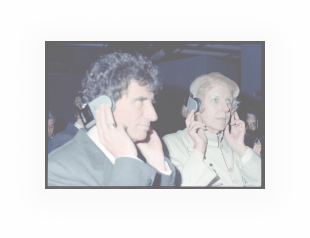LOADING THE VIRTUAL EXHIBITION TELÉCHARGEMENT DE L’EXPOSITION VIRTUELLE
PLEASE PRESS TO CONTINUE APPUYEZ SUR POUR CONTINUER

Sound is a fundamental element of this exhibition. It is advised to wear headphones for the best experience. Le son est un élément important de cette exposition virtuelle. Il est conseillé de porter des écouteurs.
Leave the virtual exhibition and return to the plan on the welcome page. Your current position will be saved. Quitter l’exposition virtuelle et revenir au plan de la page d’accueil. Votre position actuelle sera conservée.
Go back to the entrance of the virtual exhibition. Revenir à l’entrée de l’exposition virtuelle.
THE VIRTUAL EXHIBITION of EXPOSITION VIRTUELLE
-
LES IMMATÉRIAUX,
CENTRE POMPIDOU,
1985 LES IMMATÉRIAUX,
CENTRE POMPIDOU,
1985 - A LANDMARK EXHIBITION UNE EXPOSITION MARQUANTE
- A POSTMODERN DIALOGUE BETWEEN ART, SCIENCE AND NEW TECHNOLOGIES UN DIALOGUE POSTMODERNE ENTRE ARTS, SCIENCES ET NOUVELLES TECHNOLOGIES
- AN EXPERIMENTAL SCENOGRAPHY, IM‑MATERIAL, LABYRINTHINE, DISQUIETING UNE SCÉNOGRAPHIE EXPÉRIMENTALE IM‑MATÉRIELLE, LABYRINTHIQUE, TROUBLANTE
- IMMERSING THE VIEWER IN A SOUNDSCAPE ENVELOPPANT LE PUBLIC DANS UN ENVIRONNEMENT SONORE
- HERE DOCUMENTED IN A VIRTUAL REINTERPRETATION DOCUMENTÉE ICI À TRAVERS UNE RÉINTERPRÉTATION VIRTUELLE
Director: Paule Zajdermann ; scenario: Daniel Soutif and Paule Zajdermann ; production: Centre Pompidou ; music excerpt: Jonathan Harvey, Bhakti, 1982. Octave au pays des Immatériaux, 1985. Extraits.
Réalisatrice : Paule Zajdermann ; scénario : Daniel Soutif et Paule Zajdermann ; production : Centre Pompidou ; extrait musical : Jonathan Harvey, Bhakti, 1982.
Organised in 1985 by the Centre de Création Industrielle of the Centre Pompidou, ‘Les Immatériaux’ was conceived by the philosopher Jean-François Lyotard and the design theorist Thierry Chaput, working alongside a team of project managers and scientific advisors. By setting up a dialogue between artworks and scientific and technological devices, the exhibition sought to explore the shift toward a postmodern sensibility in which new technologies were profoundly disrupting relations between the human and the world.
Organisée en 1985 par le Centre de Création Industrielle du Centre Pompidou, « Les Immatériaux » a été conçue par le philosophe Jean-François Lyotard et le théoricien du design Thierry Chaput, accompagnés par une équipe de chefs de projets et de conseillers scientifiques. À travers le dialogue d’œuvres, de dispositifs scientifiques et de technologies, cette exposition interrogeait le passage de l’époque moderne à l’époque postmoderne, où les nouvelles technologies bouleversaient en profondeur les relations de l’humain au monde.
La présente exposition virtuelle, souhaite documenter la « manifestation » historique « Les Immatériaux » à travers une riche sélection de photographies et d’archives, décrites et contextualisées. Dans la version conçue pour ordinateur, cette documentation se déploie dans un espace modélisé en 3D, reflétant l’architecture, la scénographie et l’environnement sonore d’origine
Thematic texts shedding light on the history of the exhibition, its initial conception, its scenography, its sound environment and the accompanying film, concert, and conference. The presentations are structured around annotated maps, photographs, and archives. The fifth text, on programming, contains digitised catalogues from the exhibition, including English versions of the Inventaire [Inventory] catalogue and the Petit journal [Mini-Guide] of the exhibition, translated in 2022. Des chapitres thématiques éclairent l’histoire de l’exposition, sa conception, sa scénographie, son environnement sonore et la programmation qui l’accompagnait. La présentation est structurée autour de plans légendés, de photographies et d’archives. On trouve dans le cinquième chapitre, consacré à la programmation, les catalogues d’exposition numérisés, dont les versions anglaises de l’Inventaire et du Petit journal de l’exposition réalisées en 2022.
‘Les Immatériaux’ was presented in 1985 by the Centre Pompidou’s Centre de Création Industrielle. It was curated by the philosopher Jean-François Lyotard and the design theorist Thierry Chaput, working alongside a team of project managers and scientific advisors. Conceived fundamentally as a philosophical project, the exhibition explored the shift toward a postmodern sensibility in which new technologies were profoundly disrupting relations between the human and the world. « Les Immatériaux » est organisée en 1985 par le Centre de Création Industrielle du Centre Pompidou. Le philosophe Jean-François Lyotard et le théoricien du design Thierry Chaput en assurent le commissariat, accompagnés par une équipe de chefs de projets et de conseillers scientifiques. Conçue comme un essai au fondement philosophique, l’exposition interroge le passage de l’époque moderne à l’époque postmoderne, où les nouvelles technologies bouleversent en profondeur les relations de l’humain au monde.
‘Les Immatériaux’ set itself in opposition to a model of the exhibition as universal, transparent, and didactic, instead aiming to ‘provoke reflection and inquietude in the visitor in relation to the postmodern condition’. It therefore took an experimental form that played upon the notions of immateriality and disorientation. Artworks, scientific and technological devices, and industrial products were displayed across more than sixty ‘sites’ delimited by suspended metal partitions of varying opacity. Visitors were free to choose their own path between the ‘Theatre of the non-body’ and the ‘Labyrinth of language’, situated respectively at the beginning and end of the exhibition. « Les Immatériaux » s’opposent au modèle de l’exposition universelle, transparente, didactique, pour « susciter chez le visiteur une réflexion et une inquiétude au sujet de la condition postmoderne ». Elle adopte ainsi une forme expérimentale reposant sur les notions d’immatérialité et de désorientation. Les œuvres et les dispositifs plastiques, scientifiques et technologiques se déploient au sein d’une soixantaine de « sites » délimités par des parois suspendues en tissage métallique, à l’opacité variable. Allant du « Théâtre du non-corps » jusqu’au « Labyrinthe du langage », situés aux deux extrémités de l’exposition, le cheminement est libre.
Visitors were given headphones which would play a number of soundtracks triggered by a system of infra-red sensors as they moved through the space. These soundtracks—a mixture of electro-acoustic music and readings of literary, philosophical, and poetic texts—were not explanatory in nature. They formed part of a multi-sensory experience in which various levels of signs and references were superimposed and intertwined. Les visiteurs portent un casque audio diffusant des bandes sonores variant par un système de capteurs infra-rouge au gré de leurs déambulations. Composées de musiques électro-acoustiques et de lectures de textes littéraires, philosophiques et poétiques, ces sons ne sont pas explicatifs. Ils contribuent à produire une expérience multi-sensorielle où les strates de signes et de références se superposent et s’entremêlent.
This virtual exhibition offers a systematic insight into the archives of the Centre Pompidou, and is the fruit of three years of research including an oral history project on ‘Les Immatériaux’. Along with digitised versions of the soundtracks, a 3D model of the exhibition has been designed which, although not an exact reproduction, reflects the original architecture and scenography. Within the model, artworks and other exhibits appear in various modes of transparency, following a visual code that serves to indicate what is known about them today. Each of the exhibition’s sixty-five sites and some one hundred and fifty works, devices and objects exhibited are documented by a range of photographs and archives, descriptions and contextualisations. La présente exposition virtuelle offre un aperçu raisonné des archives du Centre Pompidou et résume le fruit de trois années de recherches, incluant un travail d’histoire orale autour des « Immatériaux ». Animé par les bandes sonores numérisées, l’espace modélisé en 3D reflète l’architecture et la scénographie d’origine sans les reproduire de manière mimétique. Les œuvres et les différents dispositifs s’y inscrivent en transparence, selon un code visuel reflétant l’état des connaissances réunies à leur égard. Chacun des soixante-cinq sites de l’exposition et des quelques cent vingt œuvres et dispositifs exposés sont documentés par des sélections de photographies et d’archives, décrites et contextualisées.
The archive of ‘Les Immatériaux’, like any archive, has some holes in it. To date, no photographs have been found of some of the sites. Although our research has allowed us gradually to fill in the gaps, certain unknowns still remain, and the project acknowledges these absences. The 3D models of artworks, objects, and devices are of three types: those identified in photographs from 1985 are represented in semi-transparent white; those whose appearance was documented but whose exact location within the exhibition could not be established are represented in semi-transparent black, floating in the centre of their respective sites; and finally, those whose appearance and placement are unknown are represented as black squares. Comme toute archive, celle des « Immatériaux » est lacunaire. De certains espaces ne subsiste aucune photographie identifiée à ce jour. Si les recherches permettent peu à peu de combler ces manques, certaines inconnues subsistent, dont ce projet veut rendre compte. Les œuvres et les dispositifs modélisés en 3D sont ainsi de trois types : ceux identifiés sur les photographies de 1985 sont représentés en blanc semi-transparent ; ceux dont l’apparence est documentée, mais l'emplacement exact dans les espaces d'exposition n’a pu être établi, sont représentés en noir semi-transparent, flottant au centre de leurs sites respectifs ; enfin, ceux dont l'aspect et l’emplacement sont inconnus sont représentés par un carré noir.
A team of researchers, conservators, designers and developers have collaborated on this project since January 2019. Our research in the archives and our interviews with those who participated in ‘Les Immatériaux’ are ongiong projects whose future development will allow us to continue to fill out this virtual exhibition. Une équipe de chercheurs, de conservateurs, de designers et de développeurs collabore sur ce projet depuis janvier 2019. Les recherches dans les archives et les entretiens avec les personnes qui ont participé aux Immatériaux sont des travaux au long cours, dont les évolutions futures permettront de continuer à actualiser cette exposition virtuelle.
This website uses technical cookies, embedded videos and web tracking. This helps us to improve the comfort and quality of our service. For more info read our privacy policy.


